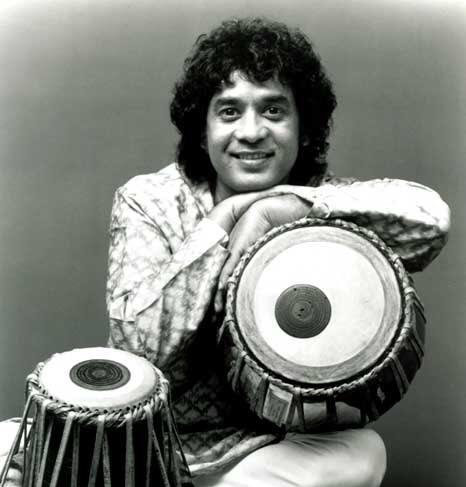One of the most innovative musicians in India, tabla maestro Ustad Zakir Hussain has played in genres as diverse as classical music, Indo-fusion, World Music and films, besides accompanying dance greats.
To mark his 71st birthday on March 9, we have selected 10 pieces from diverse genres. Some are scratch recordings but effectively display his genius. This is in no particular order.
1 The Tree of Rhythm – with Ustad Allarakha, Taufiq Qureshi, Fazal Qureshi (2002)
From Taufiq’s 2002 album ‘RhyDhun’, this tune featured his father Ustad Allarakha with his three sons. It began with the senior maestro chanting bols. In the album, Zakir also appeared on the unusual track ‘1/2 to 16’, with Taufiq on percussion, L. Shankar on violin and vocalist Geetika Varde.
2 Face To Face – with Shakti (1977)
Indo-fusion act Shakti released some fantastic albums in the 1970s. The group featured guitarist John McLaughlin, violinist L. Shankar and ghatam maestro Vikku Vinayakram. This track from the 1977 album ‘Natural Elements’ has remained a favourite for many Shakti fans. The highlight was how McLaughlin and Shankar came together after individual parts.
3 Nomads – own composition (1993)
In the early 1990s, Music Today released many theme albums inspired by natural landscapes. Zakir Hussain composed an album ‘Soundscapes: Music Of The Deserts’, using light classical, Rajasthani folk and Middle Eastern elements, played on different percussion instruments, besides rabab, sarangi and sarinda. ‘Nomads’ was one of the album’s highlights, lending feelings of peace and relaxation.
4 I Know – with L. Shankar, Jan Garbarek, Trilok Gurtu (1984)
One of the highlights of Shankar’s album ‘Song For Everyone’, this also featured saxophonist Jan Garbarek and percussionist Trilok Gurtu. The highlight was the melodic lilt backed by the steady rhythm. The album also had songs like ‘Watching You’ and ‘Rest in Peace’. It was released by the label ECM, which also had the record ‘Making Music’ with Zakir, McLaughlin, Garbarek and flautist Pt Hariprasad Chaurasia.
5 Maya – with Remember Shakti (2004)
The group Remember Shakti consisted of McLaughlin, Zakir, mandolin maestro.U Srinivas, kanjira exponent V. Selvaganesh and vocalist Shankar Mahadevan. This recording was from a 2004 concert at a jazz festival in Spain. Mahadevan didn’t appear on this song but the others teamed up to create magic. Known Mahadevan tracks with the group include ‘Sakhi’ and ‘Giriraj Sudha’.
6 Kya Tumne Hai Keh Diya – from Saaz (1997)
Though Zakir didn’t compose too many film songs, he did some interesting projects now and then. This song from Sai Paranjpye’s Saaz featured him on the tabla, with Kavita Krishnamurthy singing for Shabana Azmi. Lyricist Javed Akhtar wrote, “Kya tumne hai keh diya, kya maine hai sun liya, tum hi kaho ab main kahoon kya”.
7 Kithe Mehr Ali – from Mr And Mrs Iyer (2002)
Zakir did the songs and background music for Aparna Sen’s film Mr And Mrs Iyer starring Rahul Bose and Konkona Sensharma. In this case, he gave a fresh twist to a Sufi composition earlier made famous by Ustad Nusrat Fateh Ali Khan and Abida Parveen. Zakir used Ustad Sultan Khan’s sarangi and voice effectively, bringing in guitar and percussion after two minutes.
8 The World of Rhythm – with Mickey Hart, others (2021)
Since they released the ‘Planet Drum’ album in 1991, Zakir had worked on global rhythm projects led by Mickey Hart, once part of the band Grateful Dead. This video was released last year, as a message against racism. Congadrum expert Giovanni Hidalgo, talking drum player Sikiru Adepoju, tabla maestro Fazal Qureshi and percussionist Taufiq Qureshi joined Hart and Zakir.
9 Compositions In Teental – solo (2020)
The list had to include a solo recital, even though it is a rough concert recording that ends in an incomplete way. But the way Zakir plays compositions in the 16-beat teentaal is a treat. Ajay Joglekar gave harmonium accompaniment. One can find many solo recordings on YouTube.
10 Dhun in Bhairavi – with Ustad Rais Khan (year unknown)
We end with a dhun in raag Bhairavi, played by sitar maestro Ustad Rais Khan. This again is an incomplete and rough recording but gives an idea of the brilliance of the artistes and the coordination between them. Though the year hasn’t been mentioned, it could possibly be in the mid-1990s, to make a guess.
Here, the effort has been to stick to shorter compositions. One can of course find many full-length raags on YouTube and the streaming channels. Zakir’s fusion recordings have been covered beautifully on online platforms. There’s a world to discover out there.








